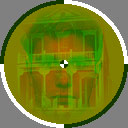



Sir Charles Wheatstone (1838) gets credit for the first systematic
study of rivalry, which can be found in his famous monograph on
binocular stereopsis. Using his newly invented mirror stereoscope
(pictured above), Wheatstone noted an odd breakdown in normal
binocular cooperation when the two eyes separately viewed different
alphabetic letters. To quote Wheatstone:
"If a and b [shown as S and A in the drawing above] are each presented at the same time to a different eye, the common border will remain constant, while the letter within it will change alternately from that which would be perceived by the right eye alone to that which would be perceived by the left eye alone. At the moment of change the letter which has just been seen breaks into fragments, while fragments of the letter which is about to appear mingle with them, and are immediately after replaced by the entire letter. It does not appear to be in the power of the will to determine the appearance of either of the letters, but the duration of the appearance seems to depend on causes which are under our control: thus if the two pictures be equally illuminated, the alternations appear in general of equal duration; but if one picture be more illuminated than the other, that which is less so will be perceived during a shorter time."
In this short passage Wheatstone offered several trenchant observations
on key aspects of rivalry, including the complete suppression
of one of two discordant stimuli, the alternations in dominance
between the eyes, the spatial fragmentation of the two images
during times of transition, and the dependence of predominance
on the physical characteristics of the rival stimuli. Demonstrations
of these concise observations are given below.
 |
 |
 |
(These images are courtesy of Frank Tong; they were used in a brain imaging study showing modulation of neural activity in the fusiform face area and the parahippocampal place area coincident with fluctuations in dominance between the two images (Tong, F., Nakayama, K., Vaughan, J.T. and Kanwisher, N., 1998: Binocular rivalry and visual awareness in human extrastriate cortex, Neuron 21, 753-759).
When observer press buttons to indicate which of the two dissimilar
images is currently dominant, the durations of the individual
button presses turn out to be successively independent -- rivalry
alternations are not strictly periodic. The distribution of durations
generally conforms to a Gamma distribution, regardless of the
particulars of the images.
Observers cannot willfully hold one image dominant indefinitely;
alternations seem obligatory.
Over time the rate of alternations tends to slow down.